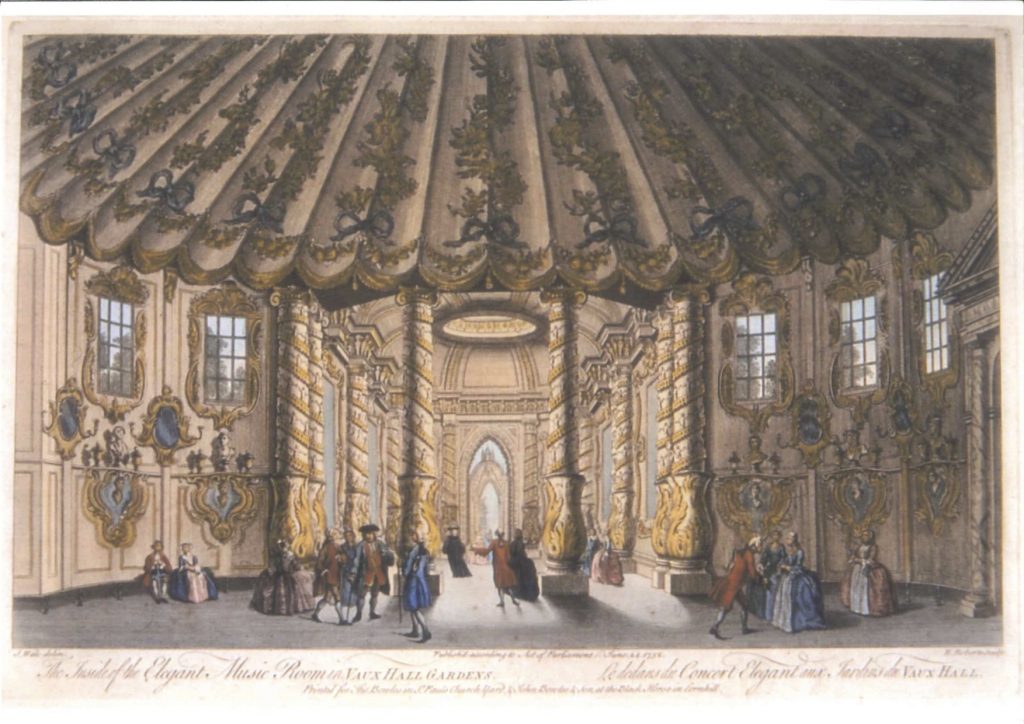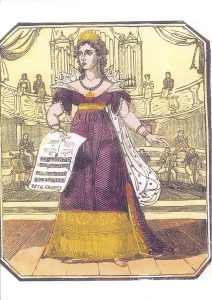Introduction
Virtual Vauxhall Gardens is a multidisciplinary project to create a multi-sensory, user-controlled, VR reconstruction of the experience of Vauxhall Gardens in 1752.
Vauxhall Gardens was re-launched in 1732 as the first and most significant of the true Pleasure Gardens of Georgian London. Commercial pleasure gardens, an English invention, were privately-run sites of entertainment; they were often situated on the outskirts of large towns or cities, and paying visitors were entertained in the summer months with music and company; refreshments were available at a price. Pleasure gardens, as their name implies, were mainly outdoor spaces, though sometimes with an assembly room or concert hall, and they were normally open in the evening, after the working day; anybody who could afford the admission price and who was at least respectably dressed would be admitted.
In re-creating this experience, we aim to widen access to and diversify audiences for historical virtual reality environments by engaging the widest range of senses (sound, vision, smell), using creative approaches and targeting non-traditional VR users. The objectives are:
- To create a head-mounted VR simulation of the rotunda of Vauxhall Gardens in 1752
- To open up new questions for historians of 18th Century social and cultural life
- To populate the rotunda with the people, sights, sounds and smells that would have provided the entertainment experience of the time
- To provide controls that enable users to moderate the nature and extent of the sensory experiences
- To develop new questions concerning the effects of multi-sensory experiences on behaviour
- To develop an understanding of how multi-sensory VR environments might be used in the heritage and commercial leisure sector
- To generate a demonstration model that will provide the basis for a larger research proposal to AHRC
- To develop partnerships with industry that will provide the basis for future projects within museum contexts.
Background
The idea of a VR reconstruction was first proposed by Lars Tharp and David Coke to Andrew Hugill (Professor of Creative Computing, University of Leicester). David’s compendious book on the subject had also provided the basis of an exhibition at the Foundling Museum, Bloomsbury, in 2012.
Hugill set about assembling a multidisciplinary team to develop the idea. In late 2018, funding was secured from the university’s Knowledge Exchange and Enterprise Development Fund (KEEF) and from the Leicester Institute of Advanced Studies to support the creation of an initial model of the Rotunda (pictured below).

Interior of the Rotunda

A singer in the Rotunda
The Rotunda was the main hub of entertainment: an indoor space that saw artistic exhibitions and musical performances as well as providing many opportunities for social interaction.
Project Team
The project as a whole is directed by Professor Andrew Hugill, whose research interests include music and sensory interactions. The enterprise partners are MBD Ltd, a company that specialises in creating VR experiences in the heritage sector. David Coke and Lars Tharp are retained as consultants to the project. The University of Leicester partners include the Biomechanics & Immersive Technology Laboratory, the Centre for Urban History, the Leicester Institute of Advanced Studies and the Attenborough Arts Centre. The teams include staff from the departments of Business, Engineering, English, History, Informatics, Museum Studies, Psychology. The team is divided into sub-teams, as follows:
History/Literature team
- Professor Roey Sweet
- Dr Kate Loveman
- Dr Stephanie Bowry
- Dr Giasemi Vavoula
Their combined expertise in 18th Century urban history, 18th Century literature, historical gardens and digital media in heritage, makes them ideally suited to develop the storyboard and historical aspects of the project.
Design team
- Professor Andrew Hugill
- Dr Michaela Butter
- Dr Jeremy Webster
Michaela and Jeremy represent the Attenborough Arts Centre, who will host the launch of the Rotunda model. They also advise on the overall design of the model. Andrew is concerned with the multi-sensory aspects of the design.
VR team
- Dr Mateusz Bocian
- Artur Soczawa-Stronczyck
- Dr Timothy Pearce
- Dr Avinash Bhangaokar
- Professor Hongji Yang
Mateusz and Artur are building the rotunda structure in the Biomechanics and Immersive Technology Lab. Tim and Avi are working on the smell delivery system. Hongji is creating usability controls.
User Experience team
- Dr Doug Barrett
- Dr David Souto
- Dr Robin Green
- Dr Giasemi Vavoula
- William Darler
This team investigates the user experience from a number of angles. Doug, David and Robin are psychologists, looking at people’s responses in virtual environments. Giasemi and William approach user experience from a museum industry perspective.
Outcomes
The major output will be a working model of an immersive and user-controlled Rotunda. This will provide the demonstration required to submit a full bid to the AHRC for a project to realise the complete Vauxhall Gardens model, which in turn will have commercial potential for international franchise and licensing. Other outcomes from the project will include:
- Publication of an article on the challenges/insights from virtual recreation of historical urban spaces, to be submitted to Urban History journal
- Publication of an article on novel approaches to user-controlled multi-sensory VR environments in Digital Creativity journal
- A final piece of equipment with sufficient temporal and concentration accuracy and multichannel capability to enable behavioural experiments related to multimodal aspects of olfactory experience, olfactory consciousness, memory and learning, emotion, spatial olfaction, sub-conscious olfactory cues
- an interdisciplinary network on which to build future grant proposals around the modelling of perception and behaviour (eye movements and walking) in virtual environments
- an understanding as to what salient parts of the gardens are remembered more than others and whether there are feature properties which make this more or less likely to be remembered
- a means to augment the experience of users with sensory deficits or psychopathology (broadly defined to include anxiety, autism etc.)
- a way to measure the way changes such as restricting the field of view (e.g., scotomas, macular degeneration) or peripheral hearing-loss affects perception and memory / learning in complex environments
- An AR app which will enable the development of evaluation methods and tools to assess its impact on visitor experience of the Gardens.
- Off-the-shelf enhancement to any future museum/gallery/conference event examining any of the several themes therein (e.g. music/ Society/ decorative arts/ 18th C England/ individual names and their environment/ places of entertainment/ IT and the re-creation of historic spaces.

 Subscribe to 's posts
Subscribe to 's posts
Recent Comments